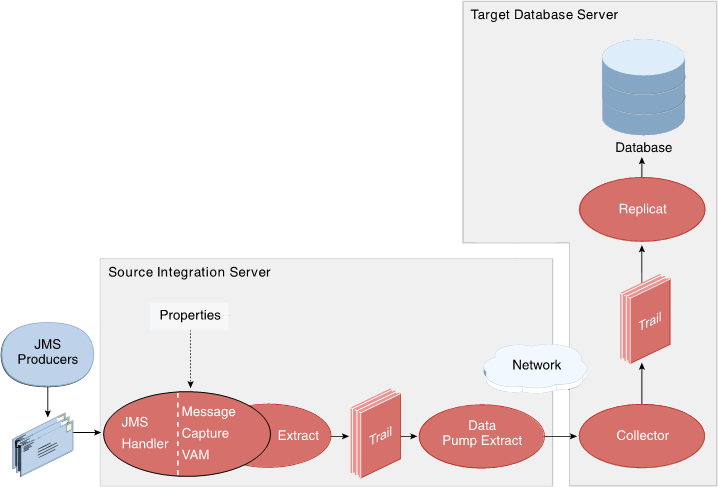2 Introducing the Java Adapter
This chapter includes the following sections.
Topics:
- Oracle GoldenGate VAM Message Capture
- Oracle GoldenGate Java Delivery
- Delivery Configuration Options
Parent topic: Understanding Oracle GoldenGate for Big Data
2.1 Oracle GoldenGate VAM Message Capture
Oracle GoldenGate VAM Message Capture only works with the Oracle GoldenGate Extract process. Oracle GoldenGate message capture connects to JMS messaging to parse messages and send them through a VAM interface to an Oracle GoldenGate Extract process that builds an Oracle GoldenGate trail of message data. This allows JMS messages to be delivered to an Oracle GoldenGate system running for a target database. Java 8 is a required dependency for Oracle GoldenGate VAM Message Capture.
Using Oracle GoldenGate JMS message capture requires the dynamically linked shared VAM library that is attached to the Oracle GoldenGate Extract process.
In a situation where a trail definition file is required to parse the resulting trail written by the Extract process, a separate utility, gendef, can be used to create an Oracle GoldenGate source definitions file.
Parent topic: Introducing the Java Adapter
2.1.1 Message Capture Configuration Options
The options for configuring the three parts of message capture are:
-
Message connectivity: Values in the property file set connection properties such as the Java classpath for the JMS client, the JMS source destination name, JNDI connection properties, and security information.
-
Parsing: Values in the property file set parsing rules for fixed width, comma delimited, or XML messages. This includes settings such as the delimiter to be used, values for the beginning and end of transactions and the date format.
-
VAM interface: Parameters that identify the VAM,
dll, orsolibrary and a property file are set for the Oracle GoldenGate core Extract process.
Parent topic: Oracle GoldenGate VAM Message Capture
2.1.2 Typical Configuration
The following diagram shows a typical configuration for capturing JMS messages.
Figure 2-1 Configuration for JMS Message Capture

Description of "Figure 2-1 Configuration for JMS Message Capture"
In this configuration, JMS messages are picked up by the Oracle GoldenGate Adapter JMS Handler and transferred using the adapter's message capture VAM to an Extract process. The Extract writes the data to a trail which is sent over the network by a Data Pump Extract to an Oracle GoldenGate target instance. The target Replicat then uses the trail to update the target database.
Parent topic: Oracle GoldenGate VAM Message Capture
2.2 Oracle GoldenGate Java Delivery
Through the Oracle GoldenGate Java API, transactional data captured by Oracle GoldenGate can be delivered to targets other than a relational database, such as a JMS (Java Message Service), files written to disk, streaming data to a Big Data application, or integration with a custom application Java API. Oracle GoldenGate Java Delivery can work with either an Extract or Replicat process. Using the Oracle GoldenGate Replicat process is considered the best practice. Oracle GoldenGate Java Delivery requires Java 8 as a dependency.
Oracle GoldenGate for Java provides the ability to execute Java code from the Oracle GoldenGate Replicat process. Using Oracle GoldenGate for Java requires the following conditions to be met:
-
A dynamically linked or shared library, implemented in C/C++, integrating an extension module of Oracle GoldenGate Replicat process.
-
A set of Java libraries (JARs), which comprise the Oracle GoldenGate Java API. This Java framework communicates with the Replicat through the Java Native Interface (JNI).
-
Java 8 must be installed and accessible on the machine hosting the Oracle GoldenGate Java Delivery process or processes. Environmental variables must be correctly set to resolve Java and its associated libraries.
Figure 2-2 Configuration for Delivering JMS Messages

Description of "Figure 2-2 Configuration for Delivering JMS Messages"
Parent topic: Introducing the Java Adapter
2.3 Delivery Configuration Options
The Java delivery module is loaded by the GoldenGate Replicat process, which is configured using the Replicat parameter file. Upon loading, the Java Delivery module is subsequently configured based on the configuration present in the Adapter Properties file. Application behavior can be customized by:
-
Editing the property files; for example to:
-
Set target types, host names, port numbers, output file names, JMS connection settings;
-
Turn on/off debug-level logging, and so on.
-
Identify which message format should be used.
-
-
Records can be custom formatted by:
-
Setting properties for the pre-existing format process (for fixed-length or field-delimited message formats, XML, JSON, or Avro formats);
-
Customizing message templates, using the Velocity template macro language;
-
(Optional) Writing custom Java code.
-
-
(Optional) Writing custom Java code to provide custom handling of transactions and operations, do filtering, or implementing custom message formats.
There are existing implementations (handlers) for sending messages using JMS and for writing out files to disk. For Big Data targets, there are built in integration handlers to write to supported databases.
There are several predefined message formats for sending the messages (for example, XML or field-delimited); or custom formats can be implemented using templates. Each handler has documentation that describes its configuration properties; for example, a file name can be specified for a file writer, and a JMS queue name can be specified for the JMS handler. Some properties apply to more than one handler; for example, the same message format can be used for JMS and files.
Parent topic: Introducing the Java Adapter